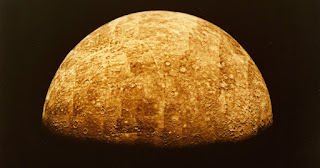Mercury
Mercury
is the smallest (3,032 miles in diameter) and most innermost planet. It is the least understood of all
planets. It has the largest eccentricity
of any planet. Two moons of Saturn are
larger than Mercury. Its temperature on the
surface can be as cold as 290 degrees below zero Fahrenheit, or as hot as 800
degrees Fahrenheit (Venus is hotter at 863 degrees Fahrenheit). The names for the features of Mercury are
odd. Craters are named for dead artists,
musicians, painters, and authors. Ridges
are named for scientists who have contributed to the study of Mercury. Depressions are named for works of
architectures. Escarpments (steep slope
or long cliff) are named for ships or scientific expeditions. Valleys are named for abandoned cities, town,
or settlements of antiquity. On average,
Mercury is closer to Earth than Venus or Mars.
Because Mercury is so close to the Sun (36 million miles), the Hubble
Space Telescope cannot observe the planet without burning out the optics. Galileo was the first person to observe
Mercury with a telescope. A trip to
Mercury requires more rocket fuel than is required to escape the Solar
System.
Mercury orbits the Sun every 87.97 Earth days at the speed of 100,000 miles per hour. It rotates three times for every two revolutions it makes around the sun.
Mercury is the densest of all planets with a large iron core. 75% of its diameter and half of its mass is molten iron.
From
Mercury, the Sun appears 11 times brighter and three times bigger than it does
on Earth.
In
1631, Pierre Gassendi made the first telescopic observations of the transit of
Mercury across the Sun.
In 1639, Giovanni Zupi used a telescope to discover that Mercury had orbital phases. This demonstrated conclusively that Mercury orbited around the Sun.
In
June 1962, Soviet scientists became the first to bounce a radar signal off
Mercury and receive it.
In 1974, Mariner 10 flew by Mercury, and repeated a flyby in 1975. Mariner 10 made three close approaches to Mercury and observed 45% of the planet. The closest approach was 203 miles from the surface. At its first close approach, a magnetic field was detected. That would mean a portion of the core is hot and liquid.
On
March 24, 1975, Mariner 10 ran out of fuel and is still orbiting the Sun.
On August 3, 2004, the MESSENGER (Mercury Surface, Space Environment, GEochemisty and Ranging) spacecraft was launched atop a Delta II rocket.
MESSENGER
had to swing by Earth once, Venus twice,
and Mercury three times to slow it down enough to orbit Mercury.
On March 18, 2011, MESSENGER became the first probe to enter orbit around Mercury. It orbited Mercury 4,100 times in four years before exhausting its fuel. It mapped 100% of the planet’s surface. It refined the size of the Caloris crater to be 960 miles wide, making it the largest impact feature on Mercury.
In November 201, NASA announced that MESSENGER discovered large quantities of nearly pure water-ice at the poles of Mercury.
On
April 30, 2015, the MESSENGER spacecraft crashed into Mercury after taking
almost 300,000 photographs. [source:
Evans, “Remembering MESSENGER’s mission to Mercury,” astronomy.com, March 18, 2011]
On October 20, 2018, the BepiColombo spacecraft was launched to orbit Mercury. This was an European and Japanese Space Agnecy effort. The spacecraft will not reach Mercury until 2025. [source: Jaggard, “Mercury Explained,” National Geographic, Jan 21, 2020]




Comments
Post a Comment